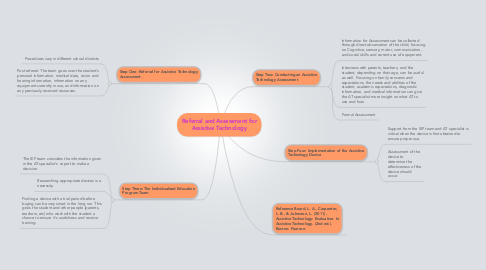Referral and Assessment for Assistive Technology
by Kathleen Patrick

1. Step One: Referral for Assistive Technology Assessment
1.1. Procedures vary in different school districts
1.2. Post referral: The team goes over the student's personal information, medical data, vision and hearing information, information on any equipment currently in use, and information on any previously received resources.
2. Step Three: The Individualized Education Program Team
2.1. The IEP team considers the information given in the AT specialist's report to make a decision.
2.2. Researching appropriate devices is a necessity.
2.3. Finding a device with a trial period before buying can be very smart in the long run. This gives the student and other people (parents, teachers, etc) who work with the student a chance to ensure it's usefulness and receive training.
3. Step Two: Conducting an Assistive Technology Assessment
3.1. Information for Assessment can be collected through direct observation of the child, focusing on Cognitive, sensory, motor, communication, and social skills and current use of equipment.
3.2. Interviews with parents, teachers, and the student, depending on their age, can be useful as well. Focusing on family concerns and expectations, the needs and abilities of the student, academic expectations, diagnostic information, and medical information can give the AT specialist more insight on what AT to use and how.
3.3. Formal Assessment
4. Step Four: Implementation of the Assistive Technology Device
4.1. Support from the IEP team and AT specialist is critical when the device is first obtained to ensure proper use.
4.2. Assessment of the device to determine the effectiveness of the device should occur.
5. Reference Beard, L. A., Carpenter, L. B., & Johnston, L. (2011). Assistive Technology: Evaluation. In Assistive Technology. (2nd ed.). Boston: Pearson.


